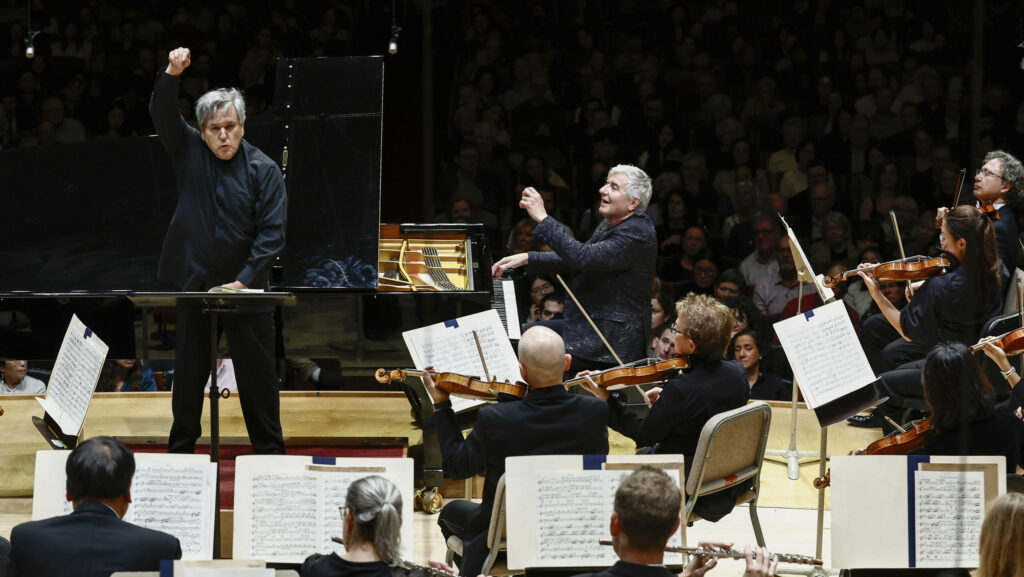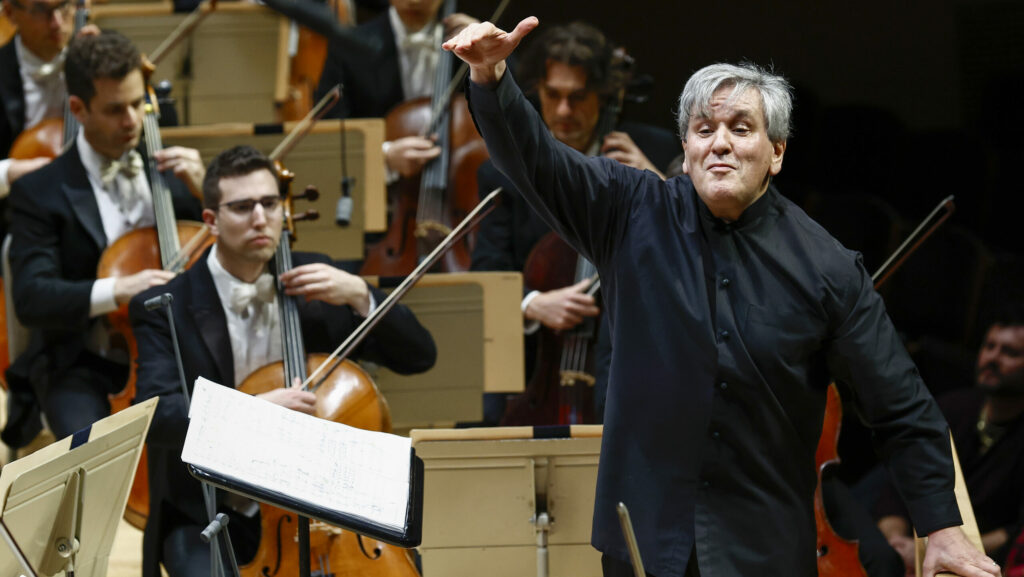
Following Richard Lynn’s insightful commentary on conducting woes at the Met, I thought of maestri who have raised musical standards in recent years. Sir Antonio Pappano was one of the names that came first to mind. Last week, Pappano led the Boston Symphony Orchestra in a short but inspired program of Hannah Kendall’s O flower of fire, Franz Liszt’s Piano Concerto No.2, and Richard Strauss’s Also Sprach Zarathustra. The conductor’s American connections (growing up in Connecticut) and decades of fine performances continue to make a case for why he should be engaged much more on this side of the Atlantic.
Pappano is in his first season as Chief Conductor of the London Symphony, having recently concluded extensive tenures at the Royal Opera House and at Orchestra dell’Accademia Nazionale di Santa Cecilia. Aside from a tour with the LSO (including a stop at Carnegie Hall in March), this was, I believe, the only time Pappano would be conducting in the US this season. This made the concert at Symphony Hall a real treat.
While daring programming often evades many major American orchestras, Pappano’s repertoire was a thoughtful combination of a new piece and well-known warhorses. The program was very similar to Pappano’s inaugural concert as Chief Conductor Designate of the LSO last year (recorded on Marquee TV), which also featured Kendall’s work (its world premiere) alongside Strauss’s tone poem, with Alice Sara Ott performing Liszt’s Totentanz. While Totentanz, a theme and variations on “Dies Irae,” is more programmatic than the Piano Concerto No.2, the latter work still eschews many elements of the mid-19th century concerto form. Liszt’s second Piano Concerto, premiered in 1857, is essentially one single movement with several contrasting sections. This structure, with its solemn middle section and rousing martial finale, resembles many of his underrated tone poems like Hunnenschlacht (also from 1857) and Hungaria (1854).
Pianist Jean-Yves Thibaudet and Pappano brought out Liszt’s formal creativity by highlighting how motivic fragments evolve over the course of the piece. The orchestra set a mournful tone in the opening woodwind chorale and the intimate back and forth between Thibaudet and cellist Blaise Déjardin brought out Liszt’s chamber music dimension. Thibaudet also relished the playfulness of the final cadenza, leading to the energetic conclusion with its up and down glissandi. Following the concerto, he linked the two halves of the program with a short but thoughtful encore: Strauss’s arrangement of Schubert’s Kupelweiser Walz.
The concert opened with the US premiere of Hannah Kendall’s brilliant O flower of fire. Addressing the audience from the stage, Kendall described how piece draws from her own Guyanese-British heritage and Martin Carter’s poetry, which examines the blend European, African, and indigenous Guyanese creations stories. One particularly noteworthy aspect of the piece is its orchestration, incorporating two prepared harps, “creolized” with mini hair claw clips and afro combs, as well as 12 harmonicas (played two at a time) and 15 music boxes playing famous tunes like “Ode to Joy” and “Amazing Grace.”
The piece opens with the quiet rattling of the prepared harps and gongs, reminiscent of Toru Takemitsu’s ethereal textures. The music boxes — played simultaneously but slowed down —— create a gentle yet foreboding wall of twinkling sound in which the individual melodies of each box became practically indiscernible. Such textures like the music boxes, clusters of harmonicas, and elegiac wah-wah trumpets, invoked what Kendall aptly called a “cloud of sound” connecting European and the Caribbean. The piece further explores this “wrestle” of creolization several times, such as brass pedal points and sliding trombones — perhaps a warped rendition of the Rheingold Prelude —trumpet attacks, and col legno effects. Like Liszt’s tone poems, Kendall vividly created sonic imagery of struggle and hope, which Pappano guided with precision and intensity.
Kendall’s and Strauss’s pieces on this program also contain many similarities: both draw from classical traditions and visual elements. Strauss quotes the Christian hymn “Credo in unum deum” when describing the yearn for religion, inserts a chamber-music section akin to the opening string sextet of his last opera Capriccio, and includes midnight chimes akin to Berlioz’s Symphonie Fantastique and Franck’s Le Chasseur Maudit (from 1883, the same year as Friedrich Nietzsche’s book Also Sprach Zarathustra). Similarly, Kendall includes a Biblical epigraph to the score of O flower of fire comparing God’s care for flowers and humanity (from which the title derives): “If then God so clothe the grass, which is to day in the field, and to morrow is cast into the oven; how much more will he clothe you, O ye of little faith?” The piece’s opening performance indication in the score reads “that strange dissolution of shape into spirit.”
Similarly, while Nietzsche’s philosophical text is framed in a quasi-Biblical structure (even though it proclaims early on that “God is dead”) — according to the philosopher, the idea for this work originated after an encounter with a “pyramidal block of stone” by a Swiss lake. For Nietzsche, the lakeside boulder epitomized the eternal yet cyclical metamorphosis of spirit in the natural world. Representing such ambitious ideas in music, however, is a challenge.
Strauss’s tone poem, meanwhile, often overstays its welcome after its iconic opening “sunrise.” Yet the Boston Symphony, who has a long history with the piece since making its first commercial recording with Serge Koussevitsky in 1935, made the most of Strauss’s muddled musical interpretation of Friedrich Nietzsche’s book. The piece’s use of recurrent motifs, however, harken to Nietzsche’s idea of the “eternal recurrence:” time itself repeats ad infinitum. These motifs, like the famous trumpet C-G-C, are not quite like Wagner’s leitmotifs (Nietzsche parodied him in the book), but rather guide the piece through various idea from the work. Strauss’s task also followed shortly after Nietzsche’s puzzling idea from the 1889 essay Nietzsche contra Wagner that music was the last stage of art and a sign of a fading culture.
The orchestra then pushed through with incredible intensity into the ferocious midnight chimes of the “Song of the Night Wanderer:” Zarathustra’s transcendence felt catastrophic rather than triumphant. This more sinister reading of the piece had a few drawbacks, like the muddled texture of double bass and cello fugue or the over-exposure of the imposing Symphony Hall organ during its brief entrances. Yet these elements did not detract from the orchestra’s goal in painting the mystical landscape inspired by Nietzsche’s words.
Pappano ditched the baton for the whole program. This decision rendered his presence on the podium even more commanding: he made stabbing gestures for the brass and bass drum interjections in O flower of fire and stood like a colossus when the thunderous organ and brass depict Zarathustra’s breakdown and collapse in the middle of Strauss’s tone poem. Pappano’s physicality shone especially the Strauss tone poem. His habit of practically singing-along with the orchestra guided the aria-like melodies and provided a clear vision for how to connect the disjointed fragments of Zarathustra’s quest for transcendence. In the “Tanzlied,” Pappano took Strauss’s “mit Schwung” direction to heart, a weightier dance compared to the Viennese waltzes of Der Rosenkavalier. In a choreographed move, he swayed back and forth as if dancing alongside the orchestra. Brisk but cheerful violin solos from Alexander Velinzon (and not, notably and confoundingly, the recently named Concertmaster Nathan Cole) animated the rustic feel as Zarathustra attempts to become one with nature.
In the closing moments, Pappano took his time with the unresolved dialogue between the B-major flutes (representing humanity) and C-major lower strings (nature), lingering on the ominous conclusion of Nietzsche’s “world riddle.” One wishes that Pappano will come back to American orchestras and opera houses soon. If Yannick Nézet-Séguin leaves the Met at the end of his contract in 2030, Pappano’s name should be near the top of possible successors.
Photos: Winslow Townson




























Comments